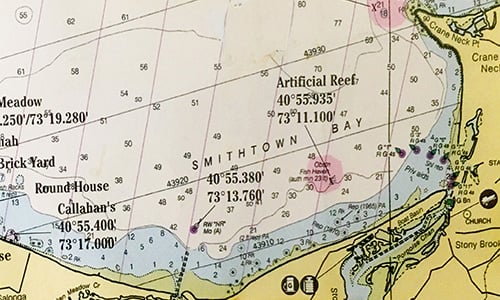SMITHTOWN BAY

While this phenomenon usually occurs sometime in May, it may come as early as April or as late as June, with water temperatures being the deciding factor. Fluke, and lots of them, follow on the heels of the sand eels and stick around for as long as the sand eels do.
Aside from a small artificial reef, Smithtown Bay is pretty much a bland body of water made up of a sandy bottom that is heavily covered with silt. The concentration of silt is the result of a combination of weak currents and the outflow of brackish water coming out of the Nissequogue River, along with sediment discharging from Stony Brook Harbor. Both the river and the harbor are part of the bay’s watershed. Water depth ranges from a few feet off the beach to 50 feet just as the bay borders into the Sound.
The first area most of the sand eels settle into is the shoal along the entire length of the shoreline in 12 to 20 feet of water. Here you will find plenty of keeper fluke to 8 pounds the first couple of weeks after the sand eels settle into the area. As the baitfish begin to move around, the 20- and 30-foot depths see the best of the action, however, the shallow 10- to 15-foot depths could still hold plenty of keeper fluke, so don’t ignore the shallows. Bucktails from 1/2- to 1-ounce tipped with 4-inch Gulp! Swimming Mullet in white works best here. The best indication that the fluke have left a particular depth is when the area becomes thick with sea robins. That will be your clue to head for deeper water. By mid-July the action shifts to the 50-foot depths and most fluke will be on the short side. Not to fret as now is a good time to hit the reef.
The Smithtown Reef (N40.55.975/W73.11.170) sits in 38 to 40 feet of water and is home to five large barges and thousands of concreted tires. Just as the bay, the entire reef is also covered in silt. However it doesn’t seem to deter tog, scup and sea bass as all three species call the inside of the barges home. Porgies will dominate catches from July through October, however by mid-October, it’s a blackfish world with fish to 8 pounds. Standard blackfish and porgy rigs do the job, with 2- to 5-ounce sinkers sufficient for this area. If you plan to do some tog fishing on this reef, it’s best to do it within the first few days of the season as the reef gets picked fairly clean in no time, making for slim pickings the rest of the season.
The abundance of sand eels here in May and June often attracts schools of bluefish that can be found roaming the surface with terns and gulls wheeling above. Keep a spinning rod rigged with a 007 jig and tube or a popper at the ready for some great light tackle action to round out your day.
